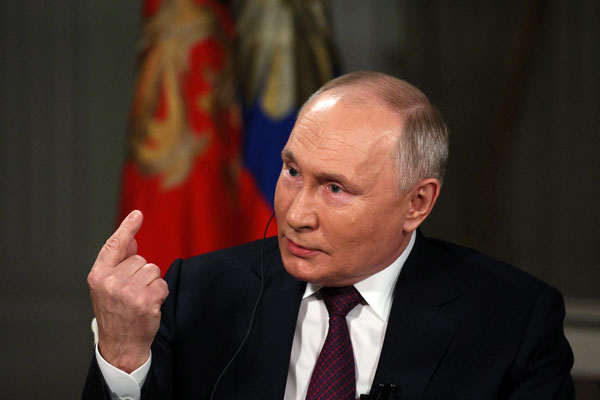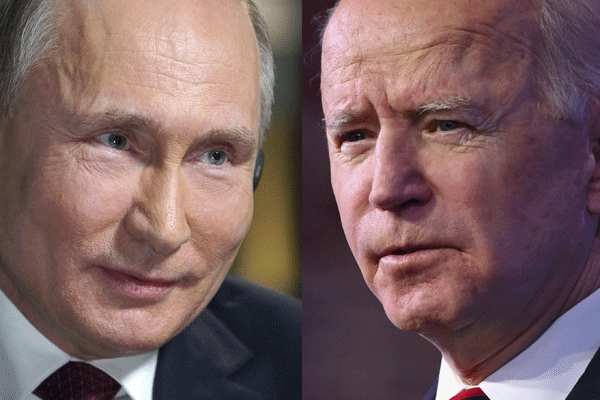
Russia's President Vladimir
On the night of February 24, 2022, Russian armies under the orders of President Vladimir Putin launched an invasion of Ukraine.
What began as a simmering conflict since 2014 escalated overnight into a full-blown assault.
Ten separate fronts erupted into violence as over 200,000 Russian troops poured into Ukraine. Their goal: the capture of the capital Kyiv.
The signs of impending war had been mounting for months. Satellite images had revealed a massive buildup of Russian forces near the border, while intelligence reports detailed meticulously coordinated plans to overwhelm the nation in just days.
Yet, when the invasion finally began, it was no less shocking. Missiles rained down on cities across Ukraine, and armoured convoys pushed forward in a brazen bid to seize control of key territories.
The urgency was most palpable in Kyiv, a city located a mere 100 kilometres from the Belarusian border – where parts of Russian armies had amassed. It quickly emerged as the focal point of Russia’s blitzkrieg strategy.
A 65-kilometer-long convoy of armoured vehicles began its ominous march toward the capital, snaking south like a colossal steel leviathan.
The world watched in anxious silence as the fate of Ukraine hung in the balance.
Simultaneously, a more sinister plan was unfolding. A decapitation strategy aimed at eradicating Ukraine’s political leadership took shape.
In February 2022, 400 elite Wagner and Kadyrovite operatives infiltrated Kyiv, armed with detailed intelligence and orders to destabilise the Ukrainian state by striking at its core.
Ukraine would later report two attempts targeting President Volodymyr Zelensky’s life. The stakes could not have been higher.
How Kyiv and Ukraine weathered those early, chaotic days remains a subject for future scholars.
Whatever their verdict, one thing is clear: this war will go down in history as one of the fiercest wars since World War II.
The enormous gamble suggests that whatever Putin hoped to gain in Ukraine, he believed it justified the enormous risks involved.
The human cost has been staggering. Recent estimates indicate that over one million soldiers have been killed or wounded.
By December 2024, figures suggested that around 80,000 Ukrainian soldiers had perished, compared to roughly 200,000 Russian soldiers.
Although both Kyiv and Moscow might dispute these numbers, my study—drawing from multiple independent sources—leads me to a conclusion not far removed from these grim estimates.
Now, as the war enters its third year, Ukraine has once again dominated global headlines.
Yet the focus has shifted. Instead of daily reports of carnage in the contested Donbas, attention centres on what the British would call Donald Trump’s ‘imaginative’ approach to the Ukraine problem.
Trump has decided to engage Russia directly, declaring it unrealistic for Ukraine to reclaim territories under Russian control.
In doing so, he upended decades of American policy toward Russia and its European allies, leaving them reeling.
As discussions continue—with the United States holding talks with Russia in Saudi Arabia and European leaders convening in Paris—the central question remains: why did Putin do this?
One cannot simply resolve this conflict without truly understanding that point.
I have long wrestled with this question. In previous writings, I questioned Russia’s invasion of Ukraine and later I highlighted Europe’s longstanding fears of Russia.
Yet, for some reasons, I often felt that the narratives I encountered never sufficed to explain the full complexity of the Ukrainian conflict.
I suspected that beneath the surface lay deeper, more convoluted reasons for the invasion.
My perspective started to shift late last year, thanks to two pivotal encounters.
On November 6, 2024, I met His Excellency Andrey Avetisyan, Russian Ambassador in Tanzania, at the Russian Cultural Centre in Dar es Salaam.
In our conversation, he presented viewpoints that made me think deeper about this issue. I remain grateful for his insights: the last thing I want is to give simplistic answers to complex problems.
Later that same month, I travelled to Ukraine, as part of a delegation from 10 African nations.
We had the opportunity to meet numerous dignitaries, including President Zelensky. Experiencing the conflict from the perspective of those directly involved and engaging other analysts from Africa proved invaluable.
These encounters not only deepened my understanding but also reinvigorated my commitment to exploring the strategic questions behind this war.
After consulting dozens of experts and reviewing extensive materials, I now feel that I have the mental clarity to tackle the central question: why did Putin gamble so heavily on Ukraine?
Its answer is crucial, reverberating far beyond Eastern Europe into global politics.
For those of us in Africa, this analysis is not just an academic exercise: it is critical for our development.
Both sides of this conflict are actively vying for our attention, and many of us take sides without seeing the full implications.
But let’s be certain: the impact of this war extend to the stability and development of our nations. It is exceedingly naïve to invoke neutrality when core principles are at stake.
In forthcoming articles, I will delve deeper into the motives behind this war, exploring the broader implications of this conflict and what it means for nations around the world.


